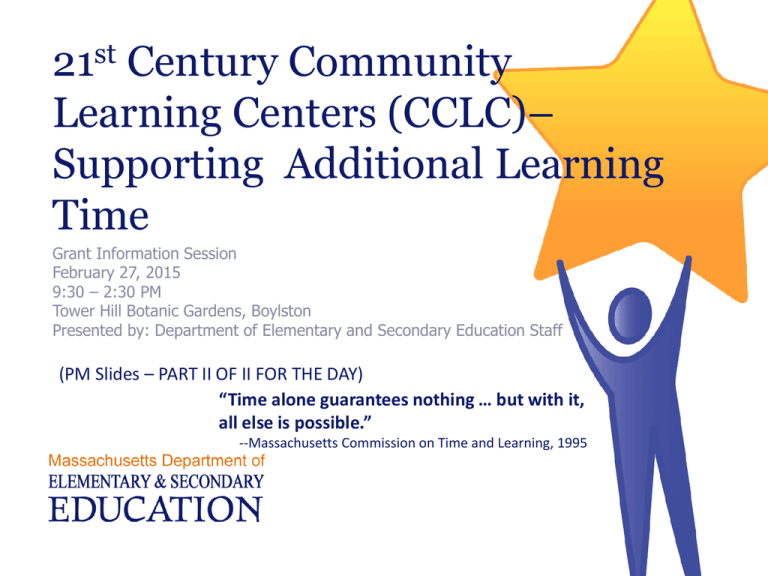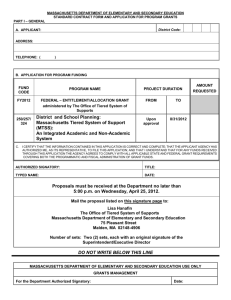PM - Grant Info Session Slides - Massachusetts Department of
advertisement

21st Century Community Learning Centers (CCLC)– Supporting Additional Learning Time Grant Information Session February 27, 2015 9:30 – 2:30 PM Tower Hill Botanic Gardens, Boylston Presented by: Department of Elementary and Secondary Education Staff (PM Slides – PART II OF II FOR THE DAY) “Time alone guarantees nothing … but with it, all else is possible.” --Massachusetts Commission on Time and Learning, 1995 More time to Engage Students Program Design Opportunities for Engaging Instruction and Enrichment Using more time to provide more opportunities for: multi-disciplinary service-learning and/or other project-based learning; creative and innovative enrichment 3 The MA 21st CCLC approach to learning focuses on strategies that engage & support students with different learning styles in gaining a greater understanding of academic content in an atmosphere the fosters creativity. How do we do this? Massachusetts Department of Elementary and Secondary Education 4 Program Design with Student Engagement in Mind When we embed academics into engaging projects… Students also develop self-expression, critical thinking, problem solving skills and positive relationships. 5 Massachusetts Department of Elementary and Secondary Education 6 Massachusetts Department of Elementary and Secondary Education Project-Based Learning (PBL) DEFINITION…PBL Creates a Learning Story it is the ongoing act of learning about different subjects simultaneously. Students gain content knowledge & academic skills, learn to solve problems, work in teams, think creatively, and communicate ideas. PBL is more than students simply making something (e.g., a collage about a story, constructing a model, or analyzing water samples from a lake). These activities could be part of a rigorous project if they help students meet a challenge. Not all "projects" involve creating a physical product; they may be in the form of a multi-media, oral or written presentation. Massachusetts Department of Elementary and Secondary Education 7 Design a Shoe Sole Students create shoe soles that meet specific needs of a potential user. Students learn about the biomechanics of the human foot in action. They researched treads and thicknesses of various athletic shoes to observe differences and similarities. • Sketch a technical drawing • Sculpt a clay model • Understand the molding process An example of this would be a student noticing that their grandmother has difficulty moving around their Apt. due to slippery floors. Guiding Questions: • Does the solution lie in changing the floors or the footwear? • Can I change her slippers to make the grip better? • Is there another product on the market that provides the ease and comfort of slippers with the safety features of shoes with more grip? Massachusetts Department of Elementary and Secondary Education 8 Drop a Dime In this class, students research a historic figure who has impacted our world in some way. Students study all aspects of this person’s life – noting the important elements that made this person so important to our world. Students then prepare a presentation based on the information they have gathered, create a costume based on the person they have selected, and actually become that person when someone “drops a dime” during the final exhibition. •This class was developed not only to build written communication and research skills, but to give students the opportunity to present their final work to an audience. •In this class, students build their writing skills by gathering relevant information from multiple sources, draw evidence from text to support their analysis, reflection, and research; and then write a narrative using effective technique, well-chosen details, and well-structured event sequences. And, they build their verbal communication skills and confidence as they present in front of an audience. Massachusetts Department of Elementary and Secondary Education 9 Program Design with Student Engagement in Mind When we embed academics into engaging projects… Students also develop self-expression, critical thinking, problem solving skills and positive relationships. 10 11 Service-Learning (SL) is… a method of teaching and learning that challenges students to identify, research, propose and implement solutions to real needs in their school or community as part of their curriculum. 12 Service-Learning is… A type of PBL Adult-facilitated process that includes: Student Ownership Academic Integrity Apprentice Citizenship 13 Wetlands Stewardship Elementary school students discovered needs/problems at East Pond Field trip to observe “Meeting” local species Students investigated cause/effect of problems and possible solutions Partners shared models of storm water runoff spread pollutants Partners educated students about solutions Wetlands Stewardship Students decided on a project – raise awareness! Create “Save East Pond” brochures Present findings to the Mayor and City Council Students… Celebrated Reflected Collaborated Made a difference… Wetlands Stewardship Students learned new knowledge and skills: Science wetlands, habitats, energy cycles, adaptations, human impacts, pollution ELA (brochures) And more… Parvo Virus Awareness Middle School students discovered the Parvo Virus problem Newspaper scan Students investigated the problem and possible solutions Internet research Visits from a local veterinarian and local animal welfare organization Parvo Virus Awareness Students decided on a project – Public Service Announcement: Vaccinate your dogs! Students planned, implemented and evaluated the impact of their project. More clinics offered for vaccination PSA continuing to run Parvo Virus Awareness Students learned new knowledge and skills: Media and technology ELA (storyboards, scripts, journals) Research And more… Questions? 5 minutes Partnerships Partnerships The most successful programs have strong school-community partnerships that support student outcomes Including academic, social-emotional, civic engagement, wellness, family involvement Organizations with the same priorities, target populations From Contractor to Collaborator; One Way to Reciprocal Relationship Partnership Examples Nature Centers Museums Theatre Arts Organizations Local Universities Environmental Organizations/Audubon Marine Wild Life Organizations YMCA’s/B&G Clubs Health/Nutrition Centers Counseling Centers Massachusetts Department of Elementary and Secondary Education 23 Questions? Evaluation & Wrap-Up Please complete the evaluation to give us feedback about today’s session. Because this is a competitive grant, we are addressing all programmatic questions during info sessions/webinars. If you have additional questions, join us for an upcoming webinar! 25 Links RFP posting: http://www.doe.mass.edu/grants/current.html 21cclc Funding Page: http://www.doe.mass.edu/21cclc/funding/FY2 016.html 26 Contact Information Call – 781-338-3010 Email Karyl – kresnick@doe.mass.edu Kristen – kmckinnon@doe.mass.edu NOTE: These slides are Part II of II for the information session. 27 28



